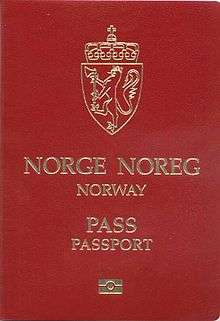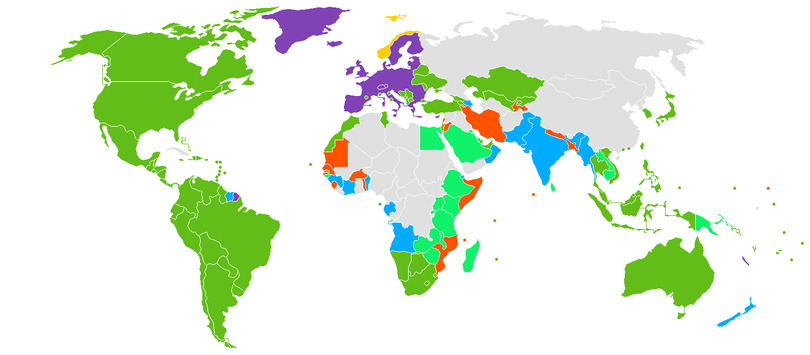Norwegian passport
Norwegian Passports are issued to nationals of Norway for the purpose of international travel. The passport may also serve as proof of Norwegian citizenship and is valid for ten years. The passport shares the standardised layout of most European Union (EU) countries, as Norway has implemented the EU passport regulation. The colour is burgundy-red and similar, but not identical to the design of most EU countries. Despite the fact Norway is not part of the EU, the country is a signatory of the Schengen Agreement and a member state of the European Economic Area (EEA). Consequently, Norwegian citizens generally have the same rights as EU citizens in EEA countries and are treated as EU citizens for the purposes of travel and entry into EEA countries and Switzerland.
| Norwegian passport | |
|---|---|
 The front cover of a contemporary Norwegian ePassport | |
| Type | Passport |
| Issued by | Norwegian Police Service |
| First issued | October 1, 2005[1] (biometric passport) January 19, 2015[2] (current version) |
| Purpose | Identification |
| Eligibility | Norwegian citizenship |
| Expiration | 2 years for children up to the age of 5; 3 years for children up to the age of 10; 5 years for individuals aged 10–16; and 10 years for individuals aged 16 and older [3] |
Types of passport
Norway issues several types of passport and travel document:[4]
- Ordinary Norwegian passport, issued to Norwegian citizens. Their covers are red.
- Refugee travel document, issued to those granted asylum in Norway. Their covers are green.
- Immigrant passport, issued to those who lack Norwegian citizenship and have a residence permit in Norway, but cannot get a passport from their country of citizenship. Their covers are blue. Holders are not permitted to travel to their country of citizenship with the passport.
- Immigrant passport for a single journey, issued to those who lack Norwegian citizenship and have a residence permit in Norway, but cannot get a passport from their country of citizenship in time for a sudden trip abroad. Their covers are also blue. The passport may only be used for a single journey.
Physical appearance and data contained
Regular Norwegian passports are burgundy in colour, with the coat of arms of Norway emblazoned in the top of the front cover. The words "NORGE", "NOREG" and "NORWAY" ("Norway" in Bokmål Norwegian (one of the two forms of Norwegian), Nynorsk Norwegian (the other form of Norwegian) and English, respectively) are inscribed below the coat of arms and the word "PASS" and "PASSPORT" emblazoned below the name of the country. The new biometric passport has the standard biometric symbol at the bottom.
Identity information page
The Norwegian passport includes the following data:
- Photo of passport holder
- Type (a two-letter code beginning with "P", e.g. "PV" for an ordinary passport)
- Code of Issuing State (NOR)
- Passport No.
- Surname
- Given Names
- Nationality (Norsk Norwegian)
- Height
- Date of birth
- Personal No.
- Sex
- Place of birth
- Authority
- Date of issue
- Holder's signature
- Date of expiry
The information page ends with the machine-readable zone starting with "PxNOR, where x indicates the type of passport. For example, ordinary passports contain "PVNOR", where the "V" presumably means "vanlig" ("ordinary" in Norwegian.)
Biometric data
The biometric passports contain an radio-frequency identification (RFID) chip containing the passport's printed data in a digital format along with the photograph in a JPEG format and with a digital key to verify that the data contained is authentic and hasn't been tampered with. The European Union required fingerprint data to be stored on member states’ passports from 2009. As a European Economic Area (EEA) member state, Norway started storing fingerprint data of persons applying for a new passport on 6 April 2010.[5]
Languages
The data page/information page is printed in Norwegian and English.
Until the 1990s, the data and information pages were printed in Norwegian, French, English and German. French and German were dropped when the data were moved to just one page.
New passport design
The Norwegian Police Directorate and Kripos (the national unit for combating organized and other serious crime) launched a design competition for new passports, ID-cards and travel documents. It was later announced that the winner of the competition was “The Norwegian Landscape” by Neue Design Studio, an Oslo-based graphic design company.
The new passports were set to be issued in 2016. But first Neue had to work closely with the National Police Directorate in order to combine the winning design with the necessary security measures that are required of passports. The purpose of the competition was to redesign the document with a high quality of design whilst still serving its purpose and functionality. Further, the new design was to increase the security of Norwegian passports, ID-cards and travel documents.[6]
In 2016 it was announced that the introduction of new passports was postponed to the middle of 2018.[7] In August 2019 it was announced that the introduction of new passports was postponed for the seventh time, to October 2020.[8]
National ID card
National ID cards are scheduled to be released at the same time as the new series of passports.[7] Citizens holding a national identity card, which states EEA or Swiss citizenship, can not only use it as an identity document within their home country, but also as a travel document to exercise the right of free movement in the EEA and Switzerland.[9] Identity cards that do not state EEA or Swiss citizenship, including national identity cards issued to residents who are not citizens, are not valid as a travel document within the EEA and Switzerland.
Identification requirements
Application is done at special passport offices or embassies. When doing the application identification of the applicant is needed. This is done by:[10]
- Showing a valid Norwegian passport, also expired, Norwegian driver's license, secure id card with image e.g. issued by banks, or a letter of acquiring Norwegian citizenship.
A person not possessing any of these identity documents must bring a person who vouches for the identity, is at least 18 years old, and has a valid Norwegian passport.
Different spellings of the same name
Names containing special letters (æ, ø, å) are spelled the correct way in the non-machine-readable zone, but are mapped in the machine-readable zone, æ becoming AE, ø becoming OE, and å becoming AA. This follows the standard for machine-readable passports, which must not contain letters other than A–Z.
Manufacturing defect
Machine-readable Norwegian passports issued between 1999 and 2005 suffered from a manufacturing defect that could result in the identity page coming loose, thus invalidating the passport. The Norwegian passport authorities replaced such passports free of charge.[11]
Visa requirements

As of 30 May 2019, Norwegian citizens had visa-free or visa on arrival access to 185 countries and territories, ranking the Norwegian passport fifth in the world in terms of travel freedom according to the Henley Passport Index.[12]
See also
- Nationality law of Norway
- Visa requirements for Norwegian citizens
- Passports of the European Union
References
- General references
- Specific citations
- "Council of the European Union - PRADO - NOR-AO-03001". www.consilium.europa.eu. Retrieved 13 April 2018.
- "Council of the European Union - PRADO - NOR-AO-05001". www.consilium.europa.eu. Retrieved 13 April 2018.
- http://prado.consilium.europa.eu/en/2124/docHome.html
- "Travel document (passport, immigrant's passport and refugee travel document)". Norwegian Directorate of Immigration. Retrieved 2020-02-22.
- "Pass med biometri (e-pass)". Norwegian Police .
- "New passports are receiving worldwide attention".
- "ID-kortene blir forsinket - igjen".
- https://www.aftenposten.no/norge/i/qL7P5e/nye-pass-og-id-kort-er-forsinket-for-syvende-gang-naa-varsler-justisministeren-gjennomgang-av-politiets-prosjektstyring
- ECB08: What are acceptable travel documents for entry clearance, UK Visas and Immigration. Retrieved 12 January 2015.
- Søknad om pass (Norwegian text)
- "Pass". Politiet. Retrieved 13 April 2018.
- "Global Ranking - Visa Restriction Index 2017" (PDF). Henley & Partners. Retrieved 14 March 2017.
External links
- Norwegian passport info on PRADO
- Images of a 1923 Norwegian passport from www.passportland.com
- Norway’s Sleek New Passports Contain a Surprise Design Feature from Slate (November 2014)